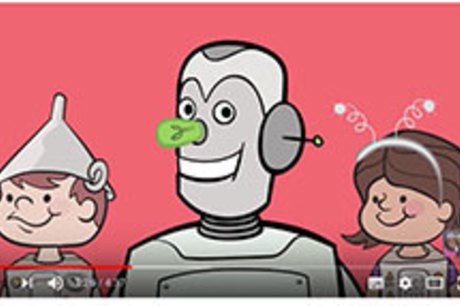Learning & Development: Computational Thinking, part 2 - In sequence
Marc Faulder
Monday, October 2, 2017
Pattern-spotting and decomposition are two of the six fundamental skills required for computational thinking. Marc Faulder examines how they best fit with what is already practised in the early years

Technology redefines the way we work and the type of work we do, so it is essential that we prepare our children for life in a digital world. In particular, this means promoting ‘computational thinking’, a skillset that can be applied to any problem-solving task and includes, more specifically, pattern-spotting and decomposition (see below).
PATTERN-SPOTTING
Spotting patterns is fundamental in early learning, and many aspects of the curriculum depend on children recognising patterns and sequences – for example, getting dressed, growing plants, dance routines, action songs, clapping games and counting.
We therefore need to encourage children to sequence experiences, recreate patterns and make up their own. A wide variety of activities can be used to promote the pattern-spotting skills required for computational thinking and then be extended to incorporate elements of coding. Let’s take dance as an example.
Let’s dance
Give children cards with actions such as ‘turn’, ‘clap’, ‘star jump’, ‘tilt’ and ‘stamp your feet’, then ask them to select three of the actions, perform them and repeat the sequence to create a pattern.
Here, children are developing dance skills and thinking about the shapes that their bodies make. They are also showing how they can develop an idea by grouping and sequencing actions that they have selected.
Pseudocode
- Discuss with the children their sequence of actions.
- Write down the sequence in your own system of symbols (pseudocode).
- Give other children the pseudocode for them to learn another dance.
- Adapt the sequence by changing the actions or adding more.
Here, children are using their pattern-spotting skills, and starting to think critically and to evaluate their actions.
Enhancing dance in this way is a small ‘tweak’ to make, but one that enables children to apply this skill more readily when they are asked to write code in Key Stage 1.
Coding
Share the Learning Station’s online video Dancing Robots and create a robot-themed dance with the children. In this ‘unplugged’ activity, the children can record the sequence of actions for their dance as symbols on paper. Discuss the sequence, then change or extend. What would the robots do in your new dance?

Make up a Bee-Bot dance. This is a ‘plugged in’ activity, in which the children use the battery-powered robot to move it forwards, backwards, left and right. What dance could the Bee-Bot do?
Don robot masks and become a shape-making robot. In this ‘unplugged’ activity, children read how many steps to take forwards or backwards, left or right, to step out the outline of 2D shapes.
In these extensions, we can see how the dance theme now incorporates the skill of coding, with children creating patterns and sequences for robots to follow.
DECOMPOSITION
When children are familiar with spotting patterns, and have practised recording patterns as written symbols (or pseudocode), they can then move on to breaking down sequences into manageable steps. This is called decomposition and is another key aspect of computational thinking.
Decomposition may be part of our daily practice without even realising it. Children regularly encounter experiences that can appear challenging and we already support them in taking a step-by-step approach, verbally and sometimes with a series of images – take, for example, self-care.
Costume changes
Changing into role-play costumes can be tricky for children and is another good example of how we need to break down the process into a series of steps:
- Take shoes off.
- Take socks off.
- Take trousers off.
- Leave pants on!
- Take jumper off.
- Take T-shirt off.
- Leave vest on!
Again this type of activity can be extended to focus more on the skills linked to computational thinking. By giving children the symbols and instructions to create their own sequences for costume changes, we can help them think critically about processes – which also links with the Characteristic of Effective Learning ‘Creating and thinking critically’.
After children have created their sequences, discuss the outcomes:
- Did the sequence work?
- What mistakes occurred?
- Was any stage missing?
Building a model
Simplifying tasks provides excellent starting points for children to understand decomposition and can also be applied to construction or art activities. Children will have their own ideas about how to make a model, for example, and to help them realise these ideas we need to pose the question ‘How can we break it down?’.
Breaking down their ideas and introducing a symbol for each stage of the process will create a step-by-step plan that children can refer to while building their model and use to evaluate their progress and the end result.
Through this approach, we can teach children about processes for both design and decomposition – and again, links to the Characteristics of Effective Learning (CoEL) and computational thinking are clear, as this approach scaffolds their decision-making and evaluation skills.
Little Red Riding Hood
As with pattern-spotting, it is only another small step to extend the skill of decomposition from computational thinking to that of coding. These activities enable children to think like a coder and write simple instructions for robots to follow:
This is an ‘unplugged’ activity. With Little Red Riding Hood and The Wolf props, children plan routes for both characters to move through a grid map of a woodland without encountering each other. Little Red Riding Hood can follow one repeating pattern and The Wolf can follow another. Children can plot the route five steps at a time to break the problem down to make sure that characters move around obstacles and away from one another at the same time. It’s like playing a board game.
This is a ‘plugged in’ activity. Children control a Bee-Bot to navigate pathways. Using masking tape, mark out tracks that measure a forward move of a Bee-Bot. At the end of the single tracks is Grandma’s house. How will Little Red Riding Hood travel on a Bee-Bot to get to Grandma’s house? Move one square or several steps at a time. Record each instruction as arrows (forwards, backwards, left and right) on paper, then repeat the whole track at the end with the complete code string.
IN CONCLUSION
We already plan many activities that support computational thinking, and can extend them easily to give children practice in coding. Developing these skills in the youngest learners can enhance our learning environments by promoting the CoEL. Whether or not children move on to becoming coders, they will still be better equipped at solving problems and prepared for a new world of work.
GLOSSARY OF TERMS
- Coding describes the process of writing step-by-step commands that a computer or software will follow to perform a task.
- Computational thinking describes the thinking skills that are needed to be a coder and relates to a skillset that can be applied to any problem-solving task. These skills also link with the Characteristics of Effective Learning and key elements of the EYFS curriculum, such as testing, predicting and identifying patterns.
- Today, good coders need to be fluent in both coding and computational thinking. They need to be able write code effectively but also be effective in evaluating problems and finding solutions using technology.
- Pseudocode are symbols that represent actions, such as forwards, backwards, left and right. This becomes an agreed symbol system that your group can use to understand instructions. They work like code.
- Decomposition is the breaking down of a complex problem or idea into manageable parts.
- Plugged and unplugged – plugged activities use technology: the resources get plugged in. These activities apply the skills of coding and computational thinking. In unplugged activities, no technology is used: the resources don’t need plugging in. These activities help to build language understanding and concepts for coding.
- There is currently a lack of continuity between the expectations of the EYFS and the Primary curriculum when it comes to digital technology. In Primary, children are taught to be effective coders through forward-thinking Computing Programmes of Study.

MORE INFORMATION
Marc Faulder will be one of the leading early years experts speaking at the Nursery World Showin London on
2 and 3 February 2018. His seminar will look at how voice and image recording technology can empower children to extend, record and reflect on their learning.
To see the full seminar and masterclass programme, visit: www.nurseryworldshow.com/london
Computational thinking, Part 1 is at: www.nurseryworld.co.uk/nursery-world/feature/1162117/learning-development-computational-thinking-think-again
Statutory guidance, http://bit.ly/2kuaR7w
Dancing Robots, www.learningstationmusic.com/blog/2014/02/16/dancing-robots-childrens-dance-song-lyrics
Marc Faulder is an early years teacher at Burton Joyce Primary School, Nottingham and an Apple distinguished educator. Part three of this series will be published in Nursery World on 30 October.




